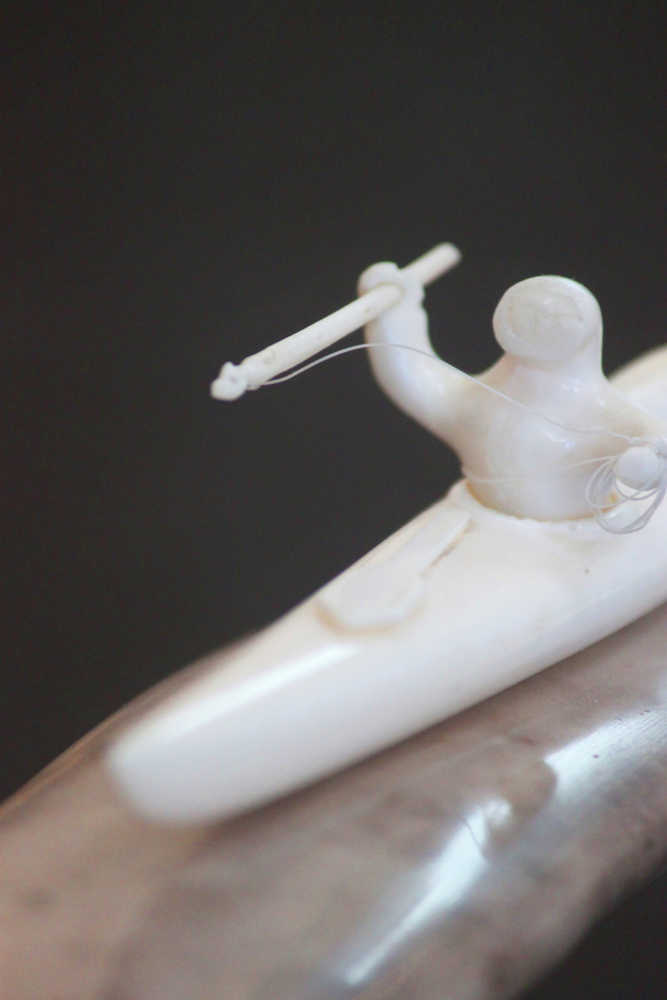What started as curiosity in 1978, progressed into James Kunkle’s 90-piece collection of ivory, baleen, bone and tooth carvings on display at the Soldotna Visitor Center.
Kunkle likens his addiction to collecting the artwork to “a guy on cocaine.”
“I just got hooked on it,” Kunkle said. “I was only planning on buying about six pieces.”
This summer, 50,000 tourists and residents will view the intricately designed artwork, Soldotna Visitor Center Coordinator Tami Murray said.
The pieces, resting inside a glass case, are the first stop at the center. The display contains items ranging from a 1-inch polished tooth with the tiny chiseled image of a women’s face, to a massive, worn and chipped mastodon tusk.
“There are some pretty unique pieces in his collection,” Tom Cooper, owner of Alaska Horn and Antler, said.
Cooper has been working with horn, tusk and bone for over three decades, and has done repairs on nearly half of Kunkle’s carvings. Using natural materials for carving is something to cherish, he said.
“It’s better sitting carved on a self, than resting at the bottom of the Bering Sea,” Cooper said.
Kunkle started his collection during what Cooper called the “heyday of ivory carving.” In recent years carving has become less common, especially with walrus ivory, since the mammal is rarely hunted anymore, he said.
According to the Marine Mammal Protection Act, walrus ivory is only legal if acquired before 1972, or “pre-Act,” or when registered by an Alaska Native as an authentic handicraft.
In fact, Cooper said, the law only allows for coastal Arctic Natives to register ivory, and effort toward the craft in that region has lessened in recent years.
“Old style” carving is distinguishable by the size of the piece and thickness of the etchings and lines, Cooper said. The large dog sleds done by Nome artists Mary and David Seppilu are good examples, he said. The color red was incorporated more often during that time period.
Modern style results in smaller carvings with thin, delicate etchings, Cooper said. Price is a major factor in this trend, he said.
If chunks of ivory are broken up that means more pieces that can be priced more reasonably, Cooper said.
The mastodon tusk alone was recently appraised at $25,000, Murray said. And the dog sled teams would go for around $5,000.
Kunkle recalls picking up the pieces while on trips to St. Lawrence Island, Homer, Seward, Kodiak, Anchorage and even nearby in Sterling. He remembers the people he bought them from as well.
Teddy and Charles Pullock, R.B. Kokuluk, and Mary and David Seppilu contributed many of the pieces, Murray said.
Ivory is only the main material used in the collection. A large woolly mammoth molar sits untouched in the back of the display, its sharp ridges pointing outward, and two dark chestnut colored woven baleen baskets rise above the minute pieces surrounding them.
Cream colored bowhead whales, harpoon wielding hooded hunters, and a foot-long walrus oosik, or penile bone, neighbor each other in the display.
After relocating to Pennsylvania, earlier this year, where he grew up as a self proclaimed “farm boy,” Kunkle put the word out he would be willing to temporarily donate his stockpile.
Murray said she jumped at the chance to house the collection. It was relocated to the visitors center in January.
Previously First National Bank and the Kenai Visitors Center had the collection on display.
Five years ago Kunkle’s wife asked him to start selling off the pieces. After she died, he continued to collect. Six of his favorite pieces are on display in his farmhouse in Pennsylvania, including a rabbit carving, which is a reflection of his wife’s love of rabbit shaped figurines.
Technically the collection belongs to his daughter; he recently sold it to her for $1, he said.
Kelly Sullivan can be reached at kelly.sullivan@peninsulaclarion.com.

